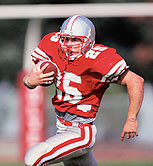
FRIDAY, April 20 (HealthDay News) — High school and youth football players sustained 14 brain injuries with long-lasting damage in 2011 — the highest number in more than 25 years — and this is a “major problem,” a new report claims.
The finding is based on an annual survey, conducted by the National Center for Catastrophic Sports Injury Research at the University of North Carolina in Chapel Hill, which collects data on catastrophic football injuries.
Although deaths from brain injuries among high school players have decreased every decade, from 128 in the 1960s to 32 in the 2000s, brain injuries with incomplete recovery reached the double digits in three of the past four years.
“The line is going down with fatalities,” said study author Frederick Mueller, director of the center and professor emeritus of exercise and sports science at UNC. “I think that’s related to kids getting better medical care on the field; they’re not dying, but they’re having permanent brain damage.”
Meanwhile, spinal cord injuries with permanent damage have mostly trended downward, with eight such injuries in 2011. There were 14 in 2008, nine in 2009 and seven in 2010.
Overall, the rate of catastrophic injuries is very low at 0.19 injuries per 100,000 players at all levels of the game. But that’s little comfort to parents whose kids are injured, Mueller said.
The National Federation of State High School Associations, the National Collegiate Athletic Association and the American Football Coaches Association funded the survey and contributed data. The survey was released this week.
There are currently 1.1 million football players at the high school level in the United States, according to the survey.
Dr. William Meehan, director of the Sports Concussion Clinic at Children’s Hospital Boston, said a closer look at the raw data might show a little less cause for alarm.
“These are numbers, not incidence, and you can see as you go through the years that it fluctuates,” Meehan said. “It’s not as if there’s some mandatory reporting system and these athletes got followed over time. We don’t have a denominator; we don’t know how many players there were, and how many practices and how many games.”
Case studies in the report included spinal fractures and bleeding or swelling in the brain, as well as one instance of a player recovering from a concussion who was cleared to play and suffered a brain bleed and stroke after a helmet-to-helmet collision.
In 1976, football organizations changed contact rules. Helmet-to-helmet contact became illegal, as did “butt blocking” (hitting the front of a player’s helmet), face tackling and intentional spearing (initiating contact with the top of an opponent’s helmet). Later, the “intentional” was removed and all spearing is now illegal.
Yet, Mueller said, “the problem is the way kids are playing: They’re using the heads more. There was a reduction in the 1970s when the new rules went into effect. Now it’s going back up.
Referees need to do a better job of enforcing safety rules, he said. “You don’t see the flags being thrown after head-to-head contact. If you get 15-yard penalties or ejection from the game, you’re going to see a difference.”
Injury expert Meehan agreed with survey recommendations, such as better player conditioning to strengthen the neck muscles. Along with reducing cervical spine injury, that would lessen impact and slow the brain “spinning” that occurs in hits that cause concussions, he noted.
Coaches need to drill players to block with their shoulders — not their heads — and to tackle with their heads up, the report said.
High school concussion rules are being revised in many states: Players showing any signs of concussion must be removed from the game immediately and cannot return without being cleared by a health professional.
Mueller said the effect of stronger concussion rules remains to be seen.
“Parents should really check with the school,” he said. “How is the coach teaching fundamentals? Are emergency action plans in effect? In some states, parents and players are required to attend meetings at the beginning of the season to talk about concussion symptoms.”
Despite better awareness and added protections, football remains a violent game, as illustrated by the National Football League’s current “bounty” scandal involving some players receiving cash bonuses for injuring opponents.
“That’s probably the worst thing that’s happened in football in a long time,” Mueller said. “High school kids see professional players on TV using their heads that way and announcers saying, ‘that’s a great hit.’ Kids think maybe that’s what they should be doing.”
More information
Visit the U.S. Centers for Disease Control and Prevention to learn about concussions in sports.

